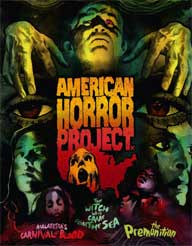 AMERICAN
HORROR PROJECT: THE PREMONITION (1976)/MALATESTA'S
CARNIVAL OF BLOOD (1973)/THE WITCH WHO CAME FROM
THE SEA (1976) Blu-ray/DVD combo
AMERICAN
HORROR PROJECT: THE PREMONITION (1976)/MALATESTA'S
CARNIVAL OF BLOOD (1973)/THE WITCH WHO CAME FROM
THE SEA (1976) Blu-ray/DVD comboDirector(s): Robert Allen Schnitzer/Christopher Eric Speeth/Matt Cimber
Arrow Video USA
 AMERICAN
HORROR PROJECT: THE PREMONITION (1976)/MALATESTA'S
CARNIVAL OF BLOOD (1973)/THE WITCH WHO CAME FROM
THE SEA (1976) Blu-ray/DVD combo
AMERICAN
HORROR PROJECT: THE PREMONITION (1976)/MALATESTA'S
CARNIVAL OF BLOOD (1973)/THE WITCH WHO CAME FROM
THE SEA (1976) Blu-ray/DVD comboArrow Video USA's ambitious AMERICAN HORROR PROJECT has NIGHTMARE USA author Stephen Thrower curating a trio of 1970s horror sleepers on special edition Blu-ray/DVD combo.
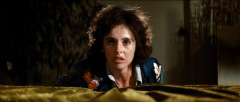
THE WITCH WHO CAME FROM THE SEA is Boticelli's Venus born from the castrated testicles of Zeus which knocked up the ocean, or so lecherous western actor Billy Batt (Rick Jason, SIERRA BARON) tells spaced out would-be conquest Molly (Millie Perkins, THE DIARY OFANNE FRANK). Molly, a barmaid on the Santa Monica Pier (Brandy, she ain't), spends her days spinning a fantasy world for herself and her nephews Tadd (Jean Pierre Camps) and Tripoli (Mark Livingston) about her beloved "untouched, perfect" sea captain father (John Goff, THE FOG) lost at sea with his "beautiful" crew; although her seamstress older sister Cathy (Vanessa Brown, THE GHOST AND MRS. MUIR) – who patches up clothing for clientele who want to look like "rich hobos" – insists that their father was an abusive drunk and that "only his brains were lost at sea." Although she maintains a warm and functional sexual relationship with her boss Long John (Lonny Chapman, THE BIRDS), Milly is drawn to "beautiful" men from the bodybuilders on the beach to television celebrities. Her fantasies, however, usually culminate in violence, and even she cannot be sure that she really tied up and castrated football stars Sam "The Electric Man" (Gene Rutherford, WILL PENNY) and Austin Slade (Jim Sims, SUCKULA) until she hears of the crime on television. It is becoming harder and harder for Molly to repress her memories ("We got lost at sea so many times") with sex, alcohol, and illicit drugs when she meets actor McPeak (Stafford Morgan, TARGETS), the handsome actor in the razor commercials (with THE BIG DOLL HOUSE's Roberta Collins) who reminds her so much of papa ("I love you on television […] Some day I'd love to shave you").
 Richly
layered with myth, psychology, and the skewering of institutions and notions
of manhood, THE WITCH WHO CAME FROM THE SEA is an underrated sleeper that could
have been even more had Cimber's direction been up to the level of the performances
and cinematographer Dean Cundey afforded more time to light and frame his Todd-AO
scope compositions (although Bob Chinn cinematographer Ken Gibb is credited
as DP and Cundey as "associate director of photography" the latter
was responsible for the bulk of the film including the use of anamorphic lenses).
Perkins – in a role written for her by then-husband Robert Thom (CULT
OF THE DAMNED, WILD IN THE STREETS) – manages to elicit sympathy or at
least understanding as the "castrating bitch" whose delusions are
enabled by family and friends too embarrassed or too kind to confront her and
a milieu of macho actors and athletes who dig crazy chicks. Perkins is ably
supported by Chapman, Brown, and Peggy Fuery (THE ORPHAN) as well-meaning fellow
barmaid Doris, all touching as they come to realize (or acknowledge) the depth
of Molly's sickness. Exploitation legend turned character actor George "Buck"
Flower (BERSERKER) not only appears as one of the detectives investigating the
murders – alongside ILSA: SHE-WOLF OF THE SS' Richard Kennedy –
he also cast the film, including his daughter Verkina (MAG WHEELS) as the young
Molly (she would appear in small roles in a handful of films throughout the
1970s and 1980s while also working on costumes and set decoration). Stan Ross
(the "I'm with you" guy from BEYOND THE VALLEY OF THE DOLLS) makes
a striking appearance as tattoo artist Jack Dracula who tattoos a mermaid on
Molly's bare chest (which turns out to have additional significance beyond her
identification with the seedier aspects of sailors and sea captains where once
she thought stated they were "untouched and perfect as God made all men
to be"). Sexploitation actor John Tull (COUNTRY CUZZINS) is credited as
assistant director. Cundey's HALLOWEEN Panaglide operator Ray Stella served
as assistant camera.
Richly
layered with myth, psychology, and the skewering of institutions and notions
of manhood, THE WITCH WHO CAME FROM THE SEA is an underrated sleeper that could
have been even more had Cimber's direction been up to the level of the performances
and cinematographer Dean Cundey afforded more time to light and frame his Todd-AO
scope compositions (although Bob Chinn cinematographer Ken Gibb is credited
as DP and Cundey as "associate director of photography" the latter
was responsible for the bulk of the film including the use of anamorphic lenses).
Perkins – in a role written for her by then-husband Robert Thom (CULT
OF THE DAMNED, WILD IN THE STREETS) – manages to elicit sympathy or at
least understanding as the "castrating bitch" whose delusions are
enabled by family and friends too embarrassed or too kind to confront her and
a milieu of macho actors and athletes who dig crazy chicks. Perkins is ably
supported by Chapman, Brown, and Peggy Fuery (THE ORPHAN) as well-meaning fellow
barmaid Doris, all touching as they come to realize (or acknowledge) the depth
of Molly's sickness. Exploitation legend turned character actor George "Buck"
Flower (BERSERKER) not only appears as one of the detectives investigating the
murders – alongside ILSA: SHE-WOLF OF THE SS' Richard Kennedy –
he also cast the film, including his daughter Verkina (MAG WHEELS) as the young
Molly (she would appear in small roles in a handful of films throughout the
1970s and 1980s while also working on costumes and set decoration). Stan Ross
(the "I'm with you" guy from BEYOND THE VALLEY OF THE DOLLS) makes
a striking appearance as tattoo artist Jack Dracula who tattoos a mermaid on
Molly's bare chest (which turns out to have additional significance beyond her
identification with the seedier aspects of sailors and sea captains where once
she thought stated they were "untouched and perfect as God made all men
to be"). Sexploitation actor John Tull (COUNTRY CUZZINS) is credited as
assistant director. Cundey's HALLOWEEN Panaglide operator Ray Stella served
as assistant camera.

Released theatrically by Cimber's Moonstone Entertainment, THE WITCH WHO CAME FROM THE SEA was long available on tape from Unicorn Video in a fetching clamshell that reproduced the original poster art but contained a severely cropped presentation of the scope feature. The short-lived Subversive Cinema label gave the film its first widescreen release, and it is from the DVD that Arrow draws its audio commentary with director Matt Cimber, director of photography Cundey, and actress Perkins and the "A Maiden's Voyage" featurette. Arrow Video's 1080p24 MPEG-4 AVC 2.35:1 widescreen encode from a 2K scan of archival 35mm elements has its share of scratches and speckles (also reflected on the LPCM 1.0 mono audio track), and may be the most damaged of the sources for the three films herein, but the high definition image sports good detail throughout giving a degree of slickness to a film that seemed carelessly shot on the panned-and-scanned VHS. Stephen Thrower provides an introduction (4:52) in which he discusses the film's undeserved reputation as a "Video Nasty" and the notions of low brow and low ambition films only interested in serving up sex and violence, and most evocatively describes the film as seeming to originate from a "cannabis fugue."
 Although
the recording conditions were not ideal, the audio commentary is a great listen
with Cimber and Perkins revealing that the project came out of a need for money
when Thom was in the hospital with pneumonia. Perkins reflecting on the role
as a departure from her post-Anne Frank roles and intimating just as much about
her relationship with Thom as she reveals (she grudgingly accepts that her husband
twisted autobiographical aspects about both their marriage and each of their
childhoods into "incest junk"). Cundey discusses convincing Cimber
if hired he could get a good deal on Todd-AO 35mm lenses which were revolutionary
at the time because they could be used on other cameras like the Arriflexes
he owned (the Panavision lenses could only be mounted on Panaflex and Mitchell
cameras) and the opportunity to experiment with Scope while elevating the apparent
production value of the film.
Although
the recording conditions were not ideal, the audio commentary is a great listen
with Cimber and Perkins revealing that the project came out of a need for money
when Thom was in the hospital with pneumonia. Perkins reflecting on the role
as a departure from her post-Anne Frank roles and intimating just as much about
her relationship with Thom as she reveals (she grudgingly accepts that her husband
twisted autobiographical aspects about both their marriage and each of their
childhoods into "incest junk"). Cundey discusses convincing Cimber
if hired he could get a good deal on Todd-AO 35mm lenses which were revolutionary
at the time because they could be used on other cameras like the Arriflexes
he owned (the Panavision lenses could only be mounted on Panaflex and Mitchell
cameras) and the opportunity to experiment with Scope while elevating the apparent
production value of the film.

The newly produced "Tides and Nightmares" featurette (23:28) reunites Cimber, Cundey, and Perkins along with actor/writer Goff. Cimber and Cundey cover a lot of the same ground while Perkins discusses how she is no longer embarrassed by the film but still hopes her daughters do not see it while she's still alive. Cundey and Goff discuss the touchy subject of working with Flower's daughter Verkina for the incest scenes. "A Maiden's Voyage" (36:13) covers the same ground with Cimber, Cundey, and Perkins looking about a decade younger. In the "Lost at Sea" featurette (3:55), Cimber discusses the series of misfortunes that befell the film after it was made. Perkins had broken up with Thom by the time of the release and was dating Jack Nicholson and was embarrassed at the time it came out. Cimber was going through a divorce and in Europe working with Mario Puzo (THE GODFATHER) and Goff (as screenwriter) in Europe on A TIME TO DIE when Movielab had gone bankrupt, and his wife had not answered the letters requesting he claim his materials; therefore the negatives were junked. The prints of his films that went to the UCLA Film Archive had mostly deteriorated, and he credits Arrow with finding a usable print of the film for Blu-ray (although he does not state whether it was the same one used for the Subversive DVD).
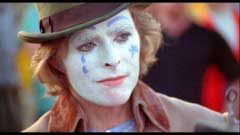 In
THE PREMONITION, emotionally unstable Andrea Fletcher (Ellen Barber, BLOOD BRIDE)
is summoned to the college town of Dover, Mississippi when former mental institution
mate turned carny clown Jude (Richard Lynch, BAD DREAMS) believes he has found
the daughter who was taken away from her and put up for adoption in young Janie
(Danielle Brisebois, later Archie Bunker's niece in ALL IN THE FAMILY and its
spin-off ARCHIE BUNKER'S PLACE), adopted child of physics professor Miles Bennett
(Edward Bell, GYMKATA) and artist wife Sheri (Sharon Farrell, IT'S ALIVE). Sheri
is unnerved when she spots Andrea talking to her daughter on the schoolyard,
but the other woman's forced entry into her home and attempted abduction of
Janie triggers a series of nightmare images that her husband believes are stress-induced
hallucinations while his new paraphysics expert Jeena Kingsly (Chitra Neogy,
ELIZA'S HOROSCOPE) believes are evidence of clairvoyance. Police detective Mark
Denver (Jeff Corey, TRUE GRIT) tries to track Andrea down and learns from her
paralyzed ex-husband (Thomas Williams) why she lost custody of Janie and gets
a clue that sets him on the right track to her current whereabouts. After the
failed abduction, Jude realizes that Andrea has been using him and murders her
in a jealous fit; and yet she continues to torment Sheri causing the woman to
believe Janie's biological mother has put a hex on her. When Janie vanishes
from a road accident, Jeena believes Sheri will have to appease Andrea's angry
spirit in order to find her daughter.
In
THE PREMONITION, emotionally unstable Andrea Fletcher (Ellen Barber, BLOOD BRIDE)
is summoned to the college town of Dover, Mississippi when former mental institution
mate turned carny clown Jude (Richard Lynch, BAD DREAMS) believes he has found
the daughter who was taken away from her and put up for adoption in young Janie
(Danielle Brisebois, later Archie Bunker's niece in ALL IN THE FAMILY and its
spin-off ARCHIE BUNKER'S PLACE), adopted child of physics professor Miles Bennett
(Edward Bell, GYMKATA) and artist wife Sheri (Sharon Farrell, IT'S ALIVE). Sheri
is unnerved when she spots Andrea talking to her daughter on the schoolyard,
but the other woman's forced entry into her home and attempted abduction of
Janie triggers a series of nightmare images that her husband believes are stress-induced
hallucinations while his new paraphysics expert Jeena Kingsly (Chitra Neogy,
ELIZA'S HOROSCOPE) believes are evidence of clairvoyance. Police detective Mark
Denver (Jeff Corey, TRUE GRIT) tries to track Andrea down and learns from her
paralyzed ex-husband (Thomas Williams) why she lost custody of Janie and gets
a clue that sets him on the right track to her current whereabouts. After the
failed abduction, Jude realizes that Andrea has been using him and murders her
in a jealous fit; and yet she continues to torment Sheri causing the woman to
believe Janie's biological mother has put a hex on her. When Janie vanishes
from a road accident, Jeena believes Sheri will have to appease Andrea's angry
spirit in order to find her daughter.
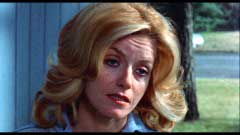
THE PREMONITION – not to be confused with Alan Rudolph's 1972 counterculture horror effort – from Robert Allen Schnitzer (REBEL) is an assured and exceptional entry in the parapsychological subgenre of the 1970s. As noted by AMERICAIN HORROR PROJECT co-curator Stephen Thrower in the optional introduction (3:16), the film is of its time as a horror film that looks at adult concerns and fears rather than the teenage concerns of the 1980s slasher film; both mothers in the film experience the horror of losing children – Sheri even before Janie's disappearance with two miscarriages – Sheri's best friend Lenore (Rosemary McNamara) is going through a divorce (the social stigma it held in the 1970s implied), and Sheri may or may not know of her husband's flirtation with colleague Jeena. Loss and compassion drive the film more so than violence, with the violent actions of Andrea and Jude an effect of mental illness more than malice (we know that Jude is a danger to Janie even if he never realizes it himself). Like any of the better films about second sight phenomena, THE PREMONITION rewards with repeat viewings as Sheri's early visions of Andrea and Jude horrifically mugging for the camera actually prefigure their emotional states at crucial moments later on in the film. Kingsly's statement during an early lecture that "clairvoyant reality is totally rejected by science and finds its expression only in art, music, religion…" is also anticipated by Sheri's paintings and borne out by the climactic setpiece. Although not as showy as some of the bigger budget films that dealt with the paranormal in the 1970s, the film does port a few technically-naïve but effective in-camera effects utilizing reverse motion, time-lapse, and lighting effectively. Editor Sidney Katz (THE SWIMMER) is assisted here by his award-winning daughter Virginia (DREAMGIRLS).
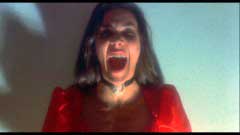 Released
theatrically by Avco Embassy (the logo of which precedes the feature presentation)
and then on tape by Embassy Home Entertainment, THE PREMONITION languished on
the video shelves until Media Blasters picked it up for their Guilty Pleasures
DVD line from which Arrow ports over the audio commentary and interview with
director Schnitzer as well as an interview with the late Lynch. The 1080p24
MPEG-4 AVC 1.85:1 widescreen transfer from a 2K restoration is bright, crisp,
and colorful (blowing the previous DVD transfer out of the water if the 4:3
letterboxed clips in the archival interviews are anything to go by). The LPCM
1.0 mono track is clean and at first seems like your run-of-the-mill low-budget
mono track until the film starts manipulating the sound design during Sheri's
visions. Composer Henry Mollicone's score can be heard on an isolated track
in LPCM 1.0 mono. Optional English SDH subtitles are also provided.
Released
theatrically by Avco Embassy (the logo of which precedes the feature presentation)
and then on tape by Embassy Home Entertainment, THE PREMONITION languished on
the video shelves until Media Blasters picked it up for their Guilty Pleasures
DVD line from which Arrow ports over the audio commentary and interview with
director Schnitzer as well as an interview with the late Lynch. The 1080p24
MPEG-4 AVC 1.85:1 widescreen transfer from a 2K restoration is bright, crisp,
and colorful (blowing the previous DVD transfer out of the water if the 4:3
letterboxed clips in the archival interviews are anything to go by). The LPCM
1.0 mono track is clean and at first seems like your run-of-the-mill low-budget
mono track until the film starts manipulating the sound design during Sheri's
visions. Composer Henry Mollicone's score can be heard on an isolated track
in LPCM 1.0 mono. Optional English SDH subtitles are also provided.

Schnitzer starts the commentary off well enough, discussing his admiration of Fellini and its influence on the film, his metaphysical beliefs, and accolades and factoids about the cast (Bell was his theater teacher in college before taking off to Los Angeles to be a working actor and was the partner of Esther Williams until her death). He purchased the original script "The Adoption" and he and writer Anthony Mahon added the parapsychological elements (the working title of the film was "Turtle Heaven"). About twenty or so minutes into the film, he falls back on play-by-play before he is joined by a soft-spoken moderator. "Pictures with a Premonition" (21:19) is a new featurette with contributions from director Schnitzer, composer Mollicone, and cinematographer Victor Milt (aka SEX WISH director/DP Tim McCoy). Schnitzler reiterates a lot of the same points from the commentary about the script's origins, casting, his metaphysical beliefs, and the production while NYC Opera musician Mollicone reveals that he wanted to try a hand at film composing and by chance contacted Schnitzer via the phone book just as he had started to look for a composer (he also plays some of the main theme on the now out-of-tune piano he used when writing the score forty years previous). Milt discusses his desire to employ the immediacy of handheld photography in the film even though he was shooting with a quarter of a million dollar Panaflex camera and Cooke zoom lenses, as well as how the effect of the mirror frosting over was achieved in-camera.
 The
aforementioned Media Blasters interview with Schnitzer (5:51) reiterates much
of the same points of the commentary and newer featurette while the Lynch interview
(16:05) is more of a freewheeling discussion on his happiness that he has been
able to make a living as a working actor with only a few minutes devoted to
the film (he does list Marcel Marceau as his inspiration for Jude during the
opening sequence but contends that actors are impressionable and absorb plenty
of inspirations through the arts without always comprehending them). Besides
the film's Avco Embassy theatrical trailer (2:23) and TV Spots (3:27), the disc
also includes three of Schnitzer's early short films: his first and second films
"Vernal Equinox" (30:08) and "A Rumbling in the Land" (11:05)
– the latter a documentary about the Students for a Democratic Society's
1969 occupation of Stony Brook University – and the meditative "Terminal
Point" (40:45). The "Peace Spots" (3:38) are a selection of anti-war
TV spots that question Nixon's concept of an "honorable peace" for
a "dishonorable war."
The
aforementioned Media Blasters interview with Schnitzer (5:51) reiterates much
of the same points of the commentary and newer featurette while the Lynch interview
(16:05) is more of a freewheeling discussion on his happiness that he has been
able to make a living as a working actor with only a few minutes devoted to
the film (he does list Marcel Marceau as his inspiration for Jude during the
opening sequence but contends that actors are impressionable and absorb plenty
of inspirations through the arts without always comprehending them). Besides
the film's Avco Embassy theatrical trailer (2:23) and TV Spots (3:27), the disc
also includes three of Schnitzer's early short films: his first and second films
"Vernal Equinox" (30:08) and "A Rumbling in the Land" (11:05)
– the latter a documentary about the Students for a Democratic Society's
1969 occupation of Stony Brook University – and the meditative "Terminal
Point" (40:45). The "Peace Spots" (3:38) are a selection of anti-war
TV spots that question Nixon's concept of an "honorable peace" for
a "dishonorable war."

MALATESTA'S CARNIVAL OF BLOOD is a sinking ship into which the naïve Norris family – father (Paul Hostetler, PANIC IN THE STREETS), mother (Betsy Henn), foolhardy son Lucky (Sebastian Stuart), and willowy daughter Vena (Janine Carazo) – invest in after being sweet-talked by callow manager Mr. Blood (Jerome Dempsey, NETWORK). Vena, however, suspects that all is not right with the oddball carnies – including hook-handed Mr. Bean (playwright Tom Markus), drag palm reader Sonja (Lenny Baker, THE HOSPITAL), and stabby groundskeeper Sticker (William Preston, THE FISHER KING) – even more so when young attendant Kit (Chris Thomas, THE FALLS) confides that Ferris Wheel investors Mr. and Mrs. Davis (Jim McCrane and Gloria Salmansohn) and their terror of a daughter Toby (Karen Salmansohn) entered the Tunnel of Love and never came out. After Lucky loses his head on the roller coaster and Vena disappears, her parents venture into the bowels of the carnival and discover a race of subhuman cannibals lorded over by Mr. Blood's business partner Malatesta (Daniel Dietrich, DAWN OF THE DEAD). When Vena's boyfriend Johnny (Paul Townsend) arrives, dwarf Bobo (FANTASY ISLAND's Hervé Villechaize) feeds him vague clues to find Vena; but is he helping him or luring another victim into the cannibal lair?
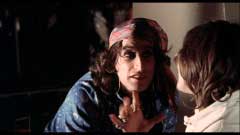 In
the optional introduction (3:41), co-curator Thrower describe the film as being
made by industry outsiders and the approach to narrative as nonconformist, like
a "strange recollection." Vera remarks after the first night's weirdness
"it was like a dream" and the film continues trying (and occasionally
succeeding) in creating a dreamlike world of unreality where humans escape cannibalistic
ghouls and then take a roller coaster ride rather than hopping the electrified
fence, and both the humans and the carny specters can change their loyalties
and moods on a dime. The lair beneath the Tunnel of Love is decorated with bizarre
works of art composed of Styrofoam cups, bubble wrap, lumber, glass, and even
the frame of a Volkswagen Beetle. A hall of mirrors is composed of shards of
mirror, reflective foil, and sheets of cellophane (possibly inverted balloons).
The camera lens and sheets of plastic and inflatable rubber work in concert
to distort the bodies of those trying to escape the lair, and Vena ends up on
an altar before a projection of THE CABINET OF DR. CALIGARI (at other points,
the area is populated by the ghouls who pass the time with other public domain
silent horror films including NOSFERATU, THE HUNCHBACK OF NOTRE DAME, and THE
PHANTOM OF THE OPERA. Although made by outsiders with artistic backgrounds,
it seems genuinely naïve in its performances and its chuckle-worthy moments
seem unintentional rather than slyly humorous. The triumph of the film seems
to be that it is genuinely weird and unclassifiable.
In
the optional introduction (3:41), co-curator Thrower describe the film as being
made by industry outsiders and the approach to narrative as nonconformist, like
a "strange recollection." Vera remarks after the first night's weirdness
"it was like a dream" and the film continues trying (and occasionally
succeeding) in creating a dreamlike world of unreality where humans escape cannibalistic
ghouls and then take a roller coaster ride rather than hopping the electrified
fence, and both the humans and the carny specters can change their loyalties
and moods on a dime. The lair beneath the Tunnel of Love is decorated with bizarre
works of art composed of Styrofoam cups, bubble wrap, lumber, glass, and even
the frame of a Volkswagen Beetle. A hall of mirrors is composed of shards of
mirror, reflective foil, and sheets of cellophane (possibly inverted balloons).
The camera lens and sheets of plastic and inflatable rubber work in concert
to distort the bodies of those trying to escape the lair, and Vena ends up on
an altar before a projection of THE CABINET OF DR. CALIGARI (at other points,
the area is populated by the ghouls who pass the time with other public domain
silent horror films including NOSFERATU, THE HUNCHBACK OF NOTRE DAME, and THE
PHANTOM OF THE OPERA. Although made by outsiders with artistic backgrounds,
it seems genuinely naïve in its performances and its chuckle-worthy moments
seem unintentional rather than slyly humorous. The triumph of the film seems
to be that it is genuinely weird and unclassifiable.
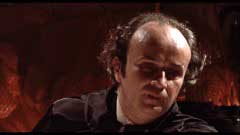
Thought lost by those who had even heard of it in the first place until Speeth himself released the film on his label Windmill Films in short supply, MALATESTA'S CARNIVAL OF BLOOD comes to Blu-ray in a 1080p24 MPEG-4 1.85:1 widescreen encode of a 2K scan of what is presumably the same print source. Detail is sharp and colors are vivid with only a vertical green scratch during the first reel. The LPCM 1.0 mono track is in good condition with the dialogue sounding crisp and the carnival music grating on the ear. Optional English SDH subtitles are also available. Film historian Richard Harland Smith provides an audio commentary track which he prefaces by stating that he loves "every frame, every sidebar, every digression, every longeur." He provides background on the Willow Park amusement park location (which was not abandoned or partially demolished at the time but definitely on its last legs) as well as interesting information about the participants that one might not pick up from their scant IMDb profiles (bratty Salmansohn became a self-help/relationship advice author who has appeared on OPRAH and written for The Huffington Post, Sebastian Stuart has become an Off-Broadway playwright and novelist, and several of the actors who have no other film or TV credits were and still are active in the Philadelphia theater scene) apart from Temple University student Carazo who was not a working actress but had appeared in a college play with THE THING's Charles Hallahan. He also suggests that Speeth's work refurbishing the Franklin Institute's walk-through giant human heart exhibit may have been an influence on the film. He does have a tendency to digress to lists like overviews of films with tarot readings and set in sinister carnivals (he notes Disney's PINOCCHIO but misses SOMETHING WICKED THIS WAY COMES) but he does convey his love for the film and provides some additional tidbits neglected by Speeth and others in the featurettes.
 In
"The Secrets of Malatesta" (14:06), director Speeth recalls how producer
Richard Grosser (who also did the effects) pitched to him the idea of horror
as a profitable low budget film venture. He reveals that while some of the actors
were cast through open tryouts, he filled the supporting cast out with stage
actors in an effort to help them eat and pay the rent between theater seasons
(while still being able to collect unemployment). He speaks warmly of those
actors, including glass-eyed Preston, Villechaize (who was subsequently jailed
when he stole the negative of another film he had done after discovering that
his role was redubbed), Baker (who was bisexual but the drag role was originally
intended for a woman), Dempsey, and Dietrich (who was independently wealthy
and did not require a salary for the film). He also reveals that his brother
Dr. Sheridan Speeth was known in the world of psychoacoustics for discovering
how to distinguish between earthquakes and nuclear explosions with audible seismographic
data, and that he worked with sound effects mixer Dan Kron on overcoming 35mm
optical track limitations in the lower range with a "fear track" of
subharmonic virtual frequencies. He discusses the MPAA-mandated cutting for
an R-rating (and how his director's cut print was trimmed to construct the film's
trailer) and as much as he knows of the film's distribution history –
the distributor was the son of Pantages Theatre chain founder Alexander Pantages
– which he did not follow up on, and the subsequent interest in the film
sparked by an interview with Thrower for NIGHTMARE USA.
In
"The Secrets of Malatesta" (14:06), director Speeth recalls how producer
Richard Grosser (who also did the effects) pitched to him the idea of horror
as a profitable low budget film venture. He reveals that while some of the actors
were cast through open tryouts, he filled the supporting cast out with stage
actors in an effort to help them eat and pay the rent between theater seasons
(while still being able to collect unemployment). He speaks warmly of those
actors, including glass-eyed Preston, Villechaize (who was subsequently jailed
when he stole the negative of another film he had done after discovering that
his role was redubbed), Baker (who was bisexual but the drag role was originally
intended for a woman), Dempsey, and Dietrich (who was independently wealthy
and did not require a salary for the film). He also reveals that his brother
Dr. Sheridan Speeth was known in the world of psychoacoustics for discovering
how to distinguish between earthquakes and nuclear explosions with audible seismographic
data, and that he worked with sound effects mixer Dan Kron on overcoming 35mm
optical track limitations in the lower range with a "fear track" of
subharmonic virtual frequencies. He discusses the MPAA-mandated cutting for
an R-rating (and how his director's cut print was trimmed to construct the film's
trailer) and as much as he knows of the film's distribution history –
the distributor was the son of Pantages Theatre chain founder Alexander Pantages
– which he did not follow up on, and the subsequent interest in the film
sparked by an interview with Thrower for NIGHTMARE USA.
 In
"Crimson Speak" (11:49) , writer Werner Liepolt reveals that he had
been in the writing program at the Annenberg School of Communication when Speeth
was in the film department, and that he brought Villechaize and some of the
other stage actors to the project from a play he had written and staged around
the time that Speeth had pitched doing a horror film. He explains that his script
was meant to be an update of the Sawney Bean cannibal family story which also
inspired THE HILLS HAVE EYES and Jack Ketchum's THE OFF-SEASON, and that his
script was tighter and more anti-bourgeois than the finished project in which
Speeth was more interested in creating memorable and unsettling images. In "Malatesta's
Underground" (10:10), art directors Richard Stange and Alan Johnson discuss
how the film's production design of recycled and junked material came about
as much out of the budget and what was available (even the machine show used
for the interior sets was a condemned building purchased by Speeth's father)
as the idea that the underground dwellers would use items left by the carnival
goers as litter and salvage from the victims. The outtakes (2:59) appear to
be the aforementioned gore snippets trimmed from Speeth's director's cut element
for the film's trailer (which is not included here). This presumably could not
have been reintegrated without interfering with the soundtrack (we see here
that a line of offscreen dialogue has more sensible placement here than in the
shorter version of the scene in the feature). A photo gallery (0:37) included,
and the film's screenplay is available as a BD-ROM file (it is also on the DVD
side as a DVD-ROM extra). (Eric
Cotenas)
In
"Crimson Speak" (11:49) , writer Werner Liepolt reveals that he had
been in the writing program at the Annenberg School of Communication when Speeth
was in the film department, and that he brought Villechaize and some of the
other stage actors to the project from a play he had written and staged around
the time that Speeth had pitched doing a horror film. He explains that his script
was meant to be an update of the Sawney Bean cannibal family story which also
inspired THE HILLS HAVE EYES and Jack Ketchum's THE OFF-SEASON, and that his
script was tighter and more anti-bourgeois than the finished project in which
Speeth was more interested in creating memorable and unsettling images. In "Malatesta's
Underground" (10:10), art directors Richard Stange and Alan Johnson discuss
how the film's production design of recycled and junked material came about
as much out of the budget and what was available (even the machine show used
for the interior sets was a condemned building purchased by Speeth's father)
as the idea that the underground dwellers would use items left by the carnival
goers as litter and salvage from the victims. The outtakes (2:59) appear to
be the aforementioned gore snippets trimmed from Speeth's director's cut element
for the film's trailer (which is not included here). This presumably could not
have been reintegrated without interfering with the soundtrack (we see here
that a line of offscreen dialogue has more sensible placement here than in the
shorter version of the scene in the feature). A photo gallery (0:37) included,
and the film's screenplay is available as a BD-ROM file (it is also on the DVD
side as a DVD-ROM extra). (Eric
Cotenas)